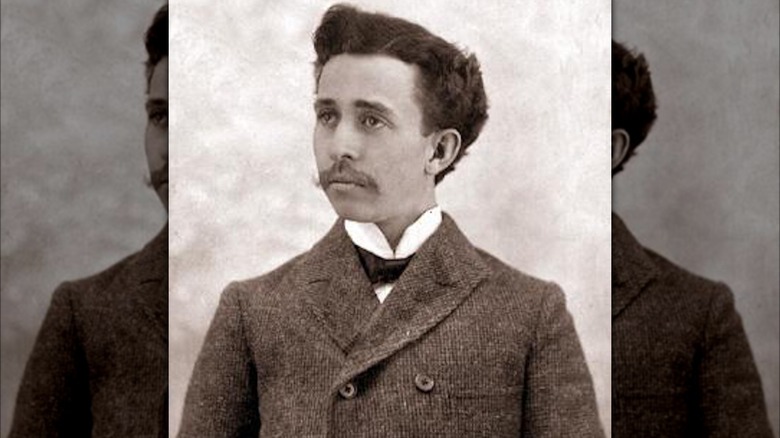Who Was The Real J.C. Penney?
The J.C. Penney department store was once a beacon of the American shopping experience. According to Zippia, the retailer peaked in 1973, boasting a surplus of 2,053 stores in total. Today, the daunting effects of bankruptcy fueled by what Forbes calls an "unsustainable debt" has left the company fading fast, with just over 650 stores left, according to the J.C. Penney website.
The combination of online shopping and a post-pandemic economy has left many corporations in financial ruin. There was a time not long ago when shopping malls and strip malls ruled the retail market, and most of them sported a J.C. Penney in their parking lot. Today, however, the future is bleak for the J.C. Penney brand, which filed for Chapter 11 bankruptcy in 2020 and has since shut down hundreds of brick-and-mortar stores. Yet, just because its peak season has come to a close doesn't mean this story is over. J.C. Penney is an undeniable chapter of a uniquely American shopping history. Who was the man behind the brand name? Did J.C. Penney ever really exist as a person? The answer might surprise you.
James Cash Penney was a real person
With a name fit for a rockstar and a mindset equipped to conduct major business, James Cash Penney was born on September 16, 1875, according to Historic Missourians. His parents, Mary Frances Paxton Penney and James Cash Penney Sr., lived in poverty-stricken Missouri, leading humble lives as farmers and preachers. By the tender age of 8, James, alternatively referred to as Jim, was already selling livestock to pay for his own clothing. He was instilled with a sense of hard labor and work ethic at an early age, despite the fact that his father was never financially compensated for his preaching and the family spending most of their lives in squalor. In fact, it was James' impoverished father who helped young J.C. Penney land the job as a store clerk that would turn out to be a goldmine for him.
On his deathbed, it is rumored that father James Cash Penney Senior said of his son (via Historic Missourians), "Jim will make it. I like the way he has started out."
Dry goods stock and humble beginnings
In his youth, J.C. Penney also struggled with poverty, but unlike his father's plight, it didn't last long. He got his first taste of retail working in a general store where he was paid a meager $2.27 — not per hour, but per month (via Britannica).To put things into perspective, that's a yearly salary of approximately $27.24, a figure that was extremely low even when compared to average wages of the time (per the Libraries University of Missouri).
Fortunately for Penney, health struggles forced him to relocate to Colorado, and it was there in the Centennial State that he met up with dry-goods merchants Guy Johnson and T.M. Callahan. He began as their employee and quickly became a partner in their dry-goods merchandising business, holding a third of the company's stock for the first five years and eventually buying out the other two shareholders completely. The store we see today as J.C. Penney actually looked a lot different back in 1902. It even had a different name (per Forbes).
1907 – JC Penney becomes sole owner of The Golden Rule Store
The store we've come to know as J.C. Penney was once a 25-foot by 40-foot brick-and-mortar dry-goods retailer — The Golden Rule Store — operating out of a small mining town called Kemmerer, Wyoming (via Forbes). Britannica reports that it wasn't until 1907 that Penney purchased both his partner's shares to become the company's sole proprietor. Between 1907 and 1912, Penney expanded The Golden Rule Store from three locations to 34, reaching an annual sales average of about $2 million.
The real change came about in 1914 when Penney made the swift decision to move the merchant headquarters from obscure Salt Lake City to bustling New York City and to officially change the name from The Golden Rule Store to J.C. Penney. In the years to follow these alterations, Penney would live to see his merchandising chain store flourish to become a billion-dollar business and the world's largest general retail corporation. All of this took place before the brand was even technically considered a department store.
From drug stores to department stores, Penney branches out
According to Britannica, James Cash Penney officially retired in 1946, holding only an honorary chairman title. It was during his retirement that changes were implemented, allowing for much diversification.
1962 marks the year when American business pioneer James Cash Penney's company started to really take some serious risks. Forbes reports that it was this year that the J.C. Penney corporation decided to abandon the company's longstanding cash-only policy and start accepting credit, a move Penney himself had previously regarded as detrimental to his cash-paying customers. The J.C. Penney corporation also embarked on a joint venture with Goodyear to ensure its location beside several auto stores across the nation (in case you've ever wondered why J.C. Penney seemed to always be nearby when you were getting a tune-up or tire rotation). Elsewhere, the businessman also joined the catalog mail order business and tied his retail company to other big names such as the General Merchandise Company and Thrift Drug Company. It was in 1963 that J.C. Penney officially became a department store, sporting its first location in Pennsylvania's popular King of Prussia Plaza (per Forbes)
On a personal note, J.C. Penney married Berta Alva Hess in 1899, and she gave birth to two sons before dying on December 26 in 1910 (per Ancestry). Throughout his 95-year lifetime, Mr. Penney would go on to marry two more times, wedding Salt Lake City-bred Mary Hortense Kimbal in 1919 (via FamilySearch) and philanthropist Caroline Marie Autenrieth in 1926 (per The New York Times).
The J.C. Penney legacy outshines its recent bankruptcy
While 2020 was a bad year for the corporation, overall, the J.C. Penney legacy endures among the world's leaders in industry and enterprise (per Forbes). It could even be argued that this legacy outshines the man behind the brand name, making this mysterious businessman a back story in the shadows of the very store he founded. Ironically, the department store peaked in its founder's retirement years and didn't become associated with shopping mall expansions until 1974, three years after James Cash Penney passed away. As you can see, the real J.C. Penney was a far cry from the credit-accepting, forever rebranding retailer that bears his name.
The J.C. Penney company took on a life of its own, but the life of its founder, James Cash Penney, was equally captivating. Born a farmer to a poor preacher, Penney turned his love of merchandising into a multi-billion-dollar enterprise that changed the way we shop and socialize. Will the corporation stay afloat post-pandemic and bankruptcy claims? Sources suggest it just might. According to Retail Dive, a new crew of eager executives is strategizing a resurgence that could even include acquiring Kohl's, although official reports on this matter have yet to be released.





